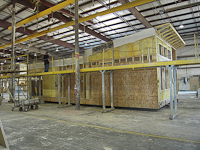
Michelle Kaufmann is a pioneer in the prefab housing movement. You might think that happened because she started a factory to manufacture architect-designed homes, or because she has showcased full-sized replicas of her homes in prominent museums like the National Building Museum in Washington, or the Museum of Science and Industry in Chicago. Those are big achievements and do identify her as an innovator and a culture shaker. But, for me, what makes her a pioneer and a leader is something else.
She is making sustainability not only a way to build, but also a state of mind.
"It's not just looking at using eco materials and choosing production and systems that are energy efficient and can save water," she said in interview. "It really goes beyond that by thinking about outdoor spaces as much as indoor spaces. It's thinking about what makes a sustainable community that goes beyond the materials themselves. It's about shared resources."
This is a holistic view of architecture and design, and it makes good sense. No building exists by itself - there's a relationship to the people who use it, to the land it is placed on, to the resources it uses.
She has a project going in Denver called aria that illustrates this. The construction is prefab, which means that much of the construction is happening off-site, in a factory, where the homes are put together in a modular fashion, then brought onto the site and completed there.

Construction is more efficient and green this way. The homes themselves use recycled materials and alternative energy sources like solar. The community features roadbed made from recycled concrete and water-conserving native plants. The design also calls for a community pavilion in which residents can learn about organic cooking, using food grown from the on-site garden.
"We're thinking about things in a more holistic way."
-Michelle Kaufmann
Over the course of her career, Michelle has championed the use of recyclable materials in the 53 green homes she has built.  She's corrected some assumptions along the way, too, such as the belief that a house made of recyclables would have to be made of old tires or that it wouldn't be possible to take a hot shower while living in one. The homes she designs not only look good, but they make us feel good.
She's corrected some assumptions along the way, too, such as the belief that a house made of recyclables would have to be made of old tires or that it wouldn't be possible to take a hot shower while living in one. The homes she designs not only look good, but they make us feel good.
This interview is part of our SHELTER project, which is about the right of everyone to have a roof over the head.
Early prefab homes designed by Michelle and others were expensive and one of a kind, but they established a necessary proof of concept. They showed clients it was possible to build green and make it beautiful. Today, the Denver site represents the next generation of prefab, as it mixes affordable and market rate housing. It's not meant to be "one of a kind," but to show that a design can be replicated at other sites, making it more accessible. This can be a path to healthier buildings, a path to architecture that is part of an ecosystem and a path to change.
"Architects can drive change, but I think we have to rethink ourselves and our role as architects." - Michelle Kaufmann
While the world celebrates star architects like Frank Gehry, it's been useful for me to remember that architecture is for the most part a conservative profession. Innovators like Michelle Kaufmann (and Gehry) are rare. Michelle told me during our interview that fewer than three percent of homes are actually designed by architects - most are done by builders, but builders are not trained to innovate, instead simply to execute. But now we are at the start of a new chapter, one that features collaboration as a critical tool for success. Michelle cited the Open Architecture network as an example of this. It makes design open and free, and promotes designs that conserve both water and energy. It's a part of the holistic view of architecture bringing us better homes and better communities.
"We are in a very interesting time. our values system is now shifting more towards community, but also community in our businesses. We're collaborating, and that's where real change is happening," Michelle said.
To learn more about her latest projects, check out her website.
Images courtesy Michelle Kaufmann, ChicagoGeek and youtubehero via Creative Commons License, and Lee Schneider.
